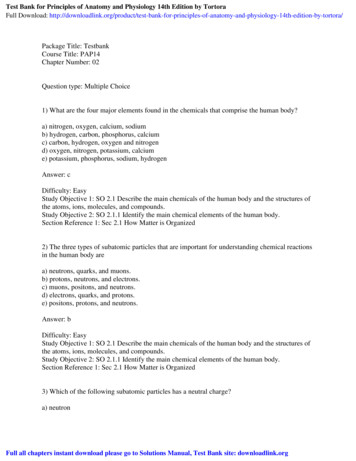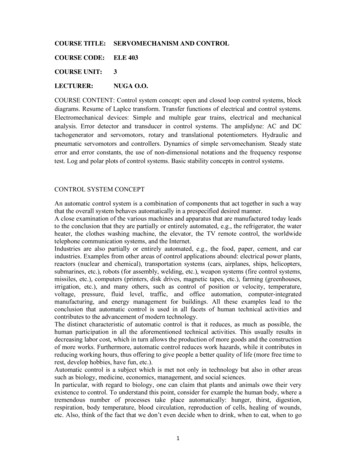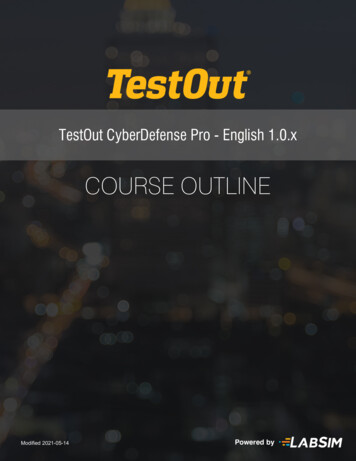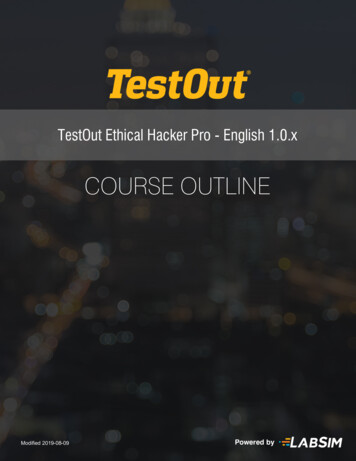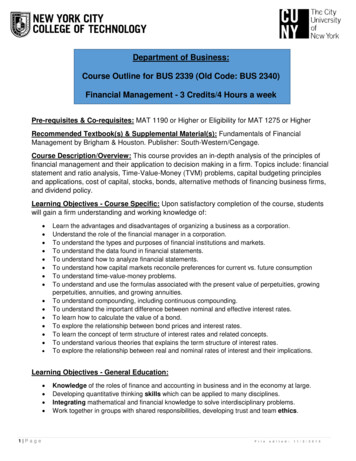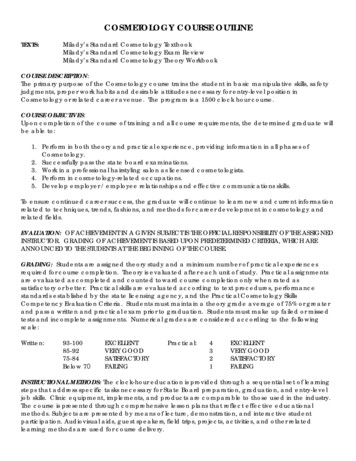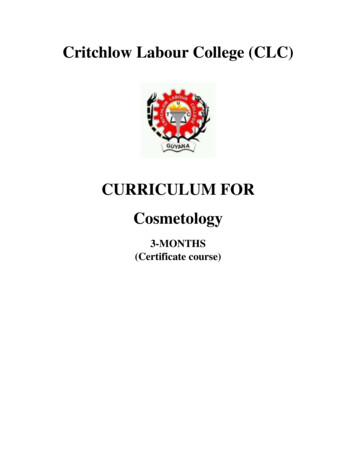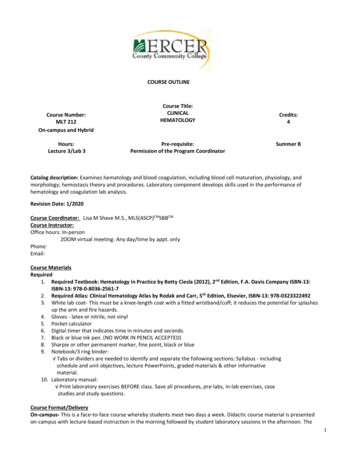
Transcription
COURSE OUTLINECourse Number:MLT 212On-campus and HybridHours:Lecture 3/Lab 3Course Title:CLINICALHEMATOLOGYPre-requisite:Permission of the Program CoordinatorCredits:4Summer BCatalog description: Examines hematology and blood coagulation, including blood cell maturation, physiology, andmorphology; hemostasis theory and procedures. Laboratory component develops skills used in the performance ofhematology and coagulation lab analysis.Revision Date: 1/2020Course Coordinator: Lisa M Shave M.S., MLS(ASCP)CMSBBCMCourse Instructor:Office hours: In-personZOOM virtual meeting: Any day/time by appt. onlyPhone:Email:Course MaterialsRequired1. Required Textbook: Hematology in Practice by Betty Ciesla (2012), 2nd Edition, F.A. Davis Company ISBN-13:ISBN-13: 978-0-8036-2561-72. Required Atlas: Clinical Hematology Atlas by Rodak and Carr, 5 th Edition, Elsevier, ISBN-13: 978-03233224923. White lab coat- This must be a knee-length coat with a fitted wristband/cuff; it reduces the potential for splashesup the arm and fire hazards.4. Gloves - latex or nitrile, not vinyl5. Pocket calculator6. Digital timer that indicates time in minutes and seconds.7. Black or blue ink pen. (NO WORK IN PENCIL ACCEPTED)8. Sharpie or other permanent marker, fine point, black or blue9. Notebook/3 ring binder: Tabs or dividers are needed to identify and separate the following sections: Syllabus - includingschedule and unit objectives, lecture PowerPoints, graded materials & other informativematerial.10. Laboratory manual: Print laboratory exercises BEFORE class. Save all procedures, pre-labs, in-lab exercises, casestudies and study questions.Course Format/DeliveryOn-campus- This is a face-to-face course whereby students meet two days a week. Didactic course material is presentedon-campus with lecture-based instruction in the morning followed by student laboratory sessions in the afternoon. The1
course requires a lot of outside proactive work by the student. The instructor will provide guidance as needed. Studentswill access and print out course materials from the course’s Blackboard shell. Assessment activities are provided as a meansof assisting students in determining their level of competence in given areas as well as to assist in reviewing forexaminations. Weekly homework assignments will be required to enhance the student’s learning experience.Hybrid- This is a web-blended course whereby didactic course material is presented mainly online and student laboratorysessions are held weekly on the college campus. The course requires a lot of outside proactive work by the student. Theinstructor will provide guidance as needed. Students will access and print out course materials from the course’sBlackboard shell. Lab manuals are available for purchase the MCCC bookstore. Assessment activities are provided as ameans of assisting students in determining their level of competence in given areas as well as to assist in reviewing forexaminations. Assignments will be posted to enhance the student’s learning experience. Online discussion boards aremandatory; they are an essential tool for communication between peers and between students and instructors. Thestudent must take all major examinations (midterm and final) at an approved testing center.Technology ExpectationsStudents must have access to a computer with Internet connection, either at home, the library or MCCC campus. A 56Kmodem connection is recommended. Mozilla Firefox 3.6 browser is recommended, although Internet Explorer 7 and 8,Google Chrome and Safari 4.3.2 can be used. AOL is NOT supported by Blackboard. Cookies, JavaScript, Active Scripting andPop-up Windows must be enabled on the browser you use.ScheduleLecture Meeting Days There are scheduled face-to-face classes.Lecture Modes of Instruction Blackboard Learning Management System (see below for access directions) Lecture PowerPoints Internet resourcesoMediaLab, Inc (click for link)oKahootoOthers (Youtube, etc.)Laboratory Room/Time MS320 on Tuesdays and Thursdays (OC) and Wednesdays (Hybrid). Face-to-facelaboratory sessions will take place in the afternoon on meeting days in Room MS320, during the semester and willbe mandatory. All laboratory procedures MUST be PRINTED for each laboratory session. Students must abide byall policies contained in the college and program handbook & Lab Safety Manual.Time CommitmentAccording to Flint’s “Surviving College,” (https://www.umflint.edu/advising/surviving college.htm) you should budget yourtime per week for this four hour credit course as follows:1. PowerPoints/Readings assigned: 3 to 6 hours2. Assignments: 3 to 6 hours3. Time for review and test preparation: 3 hours4. Total study time per week 9 to 12 hours PER WEEKBlackboard On-Line SystemThis course will be conducted via the computer on-line Blackboard learning system. Online tutorial sessions are available tohelp you understand how to use Blackboard. The dates/times can be found on the MCCC website by clicking here. Studentsmay use their home computers OR may access all materials using any public computer or electronic device. Students arestrongly advised NOT to use iPads, tablets or cell phones to take course quizzes/examinations.-Logging in to Blackboard To get to Blackboard, use this URL: Click here or you can log in through your MyMercer Portal.Enter your username, and then enter your password (the password you set up when activatingyour account). Click Login. Click the name of your course in the My Courses area to enter thecourse site. If you do not see your course listed, it may be because your instructor has not yetmade the site available. If you are sure that you registered for the course, check back later. Contactyour instructor via email if the course is not available when the semester begins. You will seecourse materials as individual documents or in folders in content areas such as Course information,2
Course Documents, or Assignments or whatever name the instructor uses. If a document is notimmediately displayed on the screen, click on the link to the file to either view it in the browser orsave it on your own computer to open with the appropriate program.Use of MCCC EmailAll students will be required to use the email address issued by MCCC to access course materials, learning activities, andquizzes on-line. (Students may forward their MCCC email to their personal email accounts, if desired. Directions onforwarding gmail accounts can be found by clicking this link: Click. In addition, all College e-mail communication (events,closings, delayed openings, etc.) to students will be sent solely to the student’s MCCC email account, with the expectationthat such communications will be read in a timely fashion.College Policies:The current college student handbook can be found by clicking here and contains important documents for understandingyour rights and responsibilities as a student in the MCCC classroom (face-to-face or online). Please read your catalog andhandbook as they supplement this syllabus, particularly for information regarding: Student Conduct Code Academic Integrity Code Student Grade Appeal ProcessCourse Goals & Competencies (CC)The student will be able to:1.Apply principles of OSHA safety regulations for blood-borne pathogens, quality assurance and quality control inHematology.2.Evaluate specimen acceptability of hematology specimens and dispose of them in the appropriate biohazardcontainers3.Demonstrate an understanding of the components of human blood and characteristics, functions, andabnormalities and disease states of each.4.Compare and contrast hematology values under normal and abnormal conditions.5.Demonstrate proficiency in the skills necessary to perform blood cell counts, and evaluation of blood elementswithin stated limits of accuracy and assess the clinical significance of the results.Mercer County Community College Institutional Learning Goals (ILG)Goal 1. Written and Oral Communication in English: Students will communicate effectively in both speech and writing.Goal 2. Mathematics: Students will use appropriate mathematical and statistical concepts and operations to interpret dataand to solve problems.Goal 3. Science: Students will use the scientific method of inquiry, through the acquisition of scientific knowledge.Goal 4. Technology or Information Literacy: Students will use computer systems or other appropriate forms of technology toachieve educational and personal goals.Goal 5. Social Science: Students will use social science theories and concepts to analyze human behavior and social andpolitical institutions and to act as responsible citizens.Goal 6. Humanities: Students will analyze works in the fields of art, music, or theater; literature; philosophy and/orreligious studies; and/or will gain competence in the use of a foreign language.Goal 7. History: Students will understand historical events and movements in World, Western, nonWestern or Americansocieties and assess their subsequent significance.Goal 8. Diversity and Global Perspective: Students will understand the importance of a global perspective and culturallydiverse peoples.Goal 9. Ethical Reasoning and Action: Students will understand ethical frameworks, issues and situations.Goal 10. Information Literacy: Students will recognize when information is needed and have the knowledge and skills tolocate, evaluate and effectively use information for college level work.Goal 11. Critical Thinking: Students will use critical thinking skills, understand, analyze, or apply information or solveproblems.3
Weeks of study:Week 1 Basic Hematology PracticesLearning ObjectivesLearning objectives (Chapters 1-4)The student should be able to:After completing this week, the student will be able to:1. Describe safe work practices, personal protective equipment and disposal of biologic hazards in thehematology lab. ILG 1, 32. Describe the components of quality assurance in the hematology laboratory. ILG 1, 33. Discuss the basic parts of the light microscope and the function and magnification of each objective. ILG 1,3, 44. Describe the organs involved in hematopoiesis throughout fetal and adult life. ILG 1, 3, 105. Define factors affecting differentiation of the pluripotent stem cell. ILG 1, 3, 106. Define the myeloid: erythroid ratio. ILG 1, 2, 37. Understand the bone marrow collection procedure and the technologist’s role in bone marrow analysis. ILG38. List the components of a complete blood count. ILG 1, 3, 109. Define and calculate red blood cell indices. ILG 1, 2, 310. Recognize normal and critical values in an automated CBC. ILG 3, 1011. Describe the clinical conditions that may produce polychromatophilic cells and elevate the reticulocytecount. ILG 1, 3, 1112. Define the morphologic classification of anemias. ILG 1, 3, 1013. Outline erythropoietic production from origin to maturation of red blood cells. ILG 1, 3, 1014. Describe immature red blood cells with regard to nucleus: cytoplasm ratio, cytoplasm color, nuclearstructure and size. ILG 1, 315. Identify the metabolic pathways that provide energy for red blood cells. ILG 316. Describe the composition of the red blood cell membrane. ILG 1, 317. Understand factors necessary for maintaining a normal red blood cell life span. ILG 318. Define anisocytosis, poikilocytosis, microcytic and macrocytic. ILG 1, 3, 1019. Indicate clinical conditions in which variations in size and hemoglobin content are seen. ILG 3, 1020. Identify the pathophysiology and the clinical conditions that may lead to target cells, spherocytes,ovalocytes and elliptocytes, sickle cells, and fragmented cells. ILG 3, 10, 1121. List the most common red blood cell inclusions and the disease states in which they are observed. ILG 1, 322. Describe hemoglobin structure and function of normal adult hemoglobin, Hgb A, Hgb A2 and Hgb F. ILG 1, 323. Relate the shift from fetal hemoglobin to adult hemoglobin. ILG 1, 3, 10, 11Psychomotor Performance Objectives:1. Demonstrate safe laboratory practices. ILG 32. Show proficiency in making peripheral blood smears. ILG 33. Recognize and differentiate between normal and abnormal RBC morphology using staining techniques. ILG3, 10Week 2 Red Cell DisordersLearning ObjectivesLearning objectives (Chapters 5-8)The student learner should be able to:1. Describe red blood cell indices related to microcytic anemias. ILG 1, 3, 102. Describe iron transport from ingestion to incorporation in hemoglobin. ILG 1, 3, 113. Identify the laboratory tests used in the diagnosis of iron deficiency anemia. ILG 3, 44. Define the pathophysiology, diagnosis and clinical management of patients with hereditaryhemochromatosis. ILG 1, 3, 105. Describe the basic pathophysiologic defect in the thalassemia syndromes. ILG 1, 36. Correlate the morphologic changes in the red blood cell with the defect in the alpha and beta thalassemias.ILG 37. Describe the criteria that define a macrocytic anemia as megaloblastic. ILG 1, 3, 104
5.Compare and contrast the morphologic characteristics of megaloblasts and normoblasts in the bonemarrow. ILG 1, 3, 11Describe the pathway of vitamin B12 and folic acid from ingestion through incorporation into the red bloodcell. ILG 1, 3, 11Define pernicious anemia and its clinical and laboratory findings. ILG 1, 3, 10Describe laboratory tests used in the diagnosis of megaloblastic anemia. ILG 1, 3Differentiate the anemias that are macrocytic but are not megaloblastic. ILG 3, 10Review the functions of the spleen as they relate to red blood cells ILG 3Describe the clinical findings in patients with hereditary spherocytosis. ILG 1, 3Describe the osmotic fragility test and its clinical usefulness. ILG 1, 4Identify the red blood cell membrane defects and peripheral smear findings in hereditary stomatocytosis,elliptocytosis, and poikilocytosis. ILG 3, 10Define the pathophysiology of the red blood cell biochemical disorders including glucose- 6- phosphatedehydrogenase deficie
Blackboard shell. Lab manuals are available for purchase the MCCC bookstore. Assessment activities are provided as a means of assisting students in determining their level of competence in given areas as well as to assist in reviewing for examinations. Assignments will be posted to enhance the students learning experience. Online discussion boards are mandatory; they are an essential tool for .

